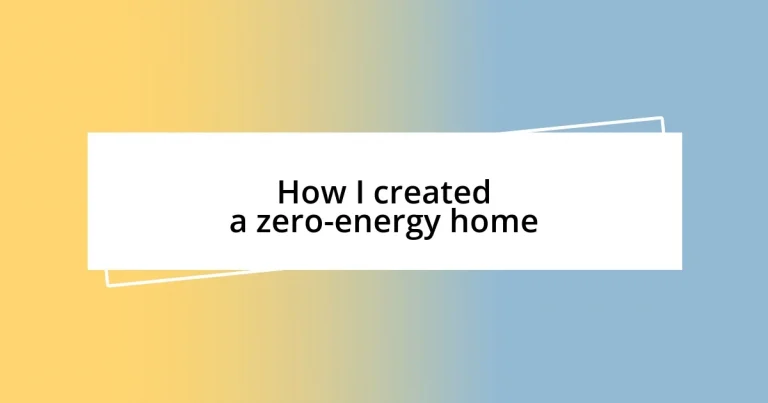Key takeaways:
- A zero-energy home (ZEH) balances energy consumption and production through renewable sources and energy-efficient design.
- Choosing sustainable materials, such as reclaimed wood and cellulose insulation, enhances environmental friendliness and energy efficiency.
- Implementing renewable energy systems, like solar panels and geothermal heating, alongside energy-efficient technologies leads to reduced reliance on external power sources.
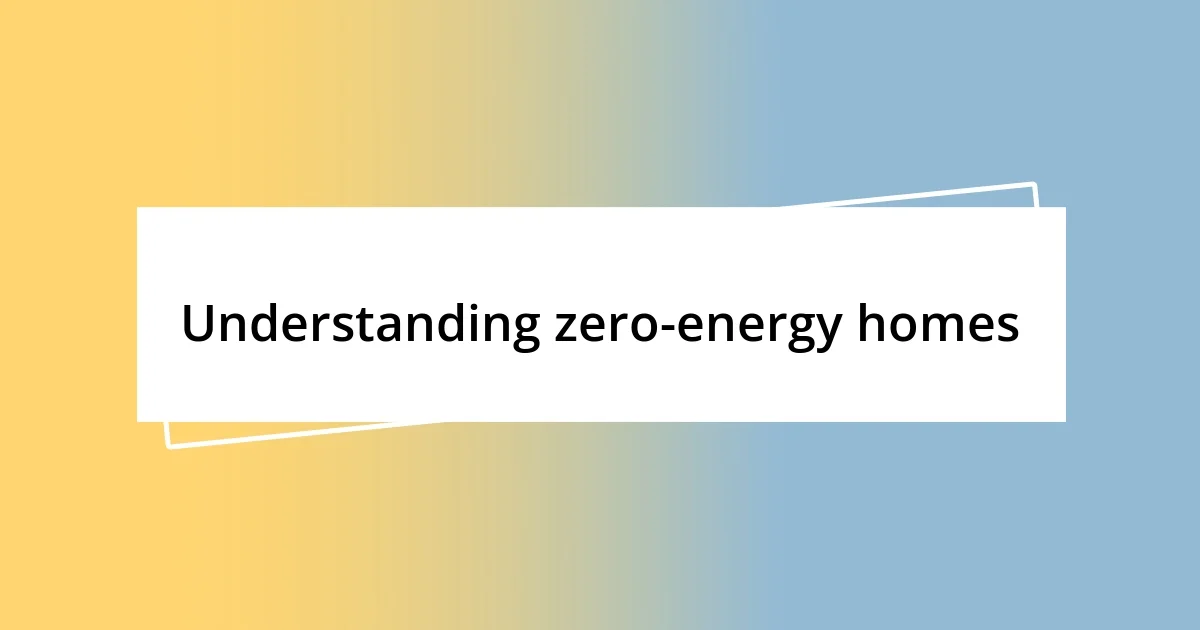
Understanding zero-energy homes
A zero-energy home (ZEH) produces as much energy as it consumes over a year, effectively balancing energy use with energy creation. I remember the first time I grasped this concept; it hit me like a light bulb moment. Imagine living in a house where your utility bills vanish!
To achieve this balance, zero-energy homes rely on renewable energy sources, such as solar panels, and are designed for energy efficiency through superior insulation and smart appliances. When I completed the energy-efficient upgrades in my own home, I felt a surge of pride. It was like giving my house a fresh, eco-friendly makeover, and the thought of reducing my carbon footprint deeply resonated with me.
You might wonder how realistic it is to create a zero-energy home. From my perspective, it’s absolutely achievable, especially with the right planning and tools. Starting this journey transformed how I viewed energy consumption, leading me to appreciate the importance of every small efficiency tweak, from LED lighting to energy-efficient windows. What I found surprising was that these changes made my home not only more sustainable but also more comfortable.
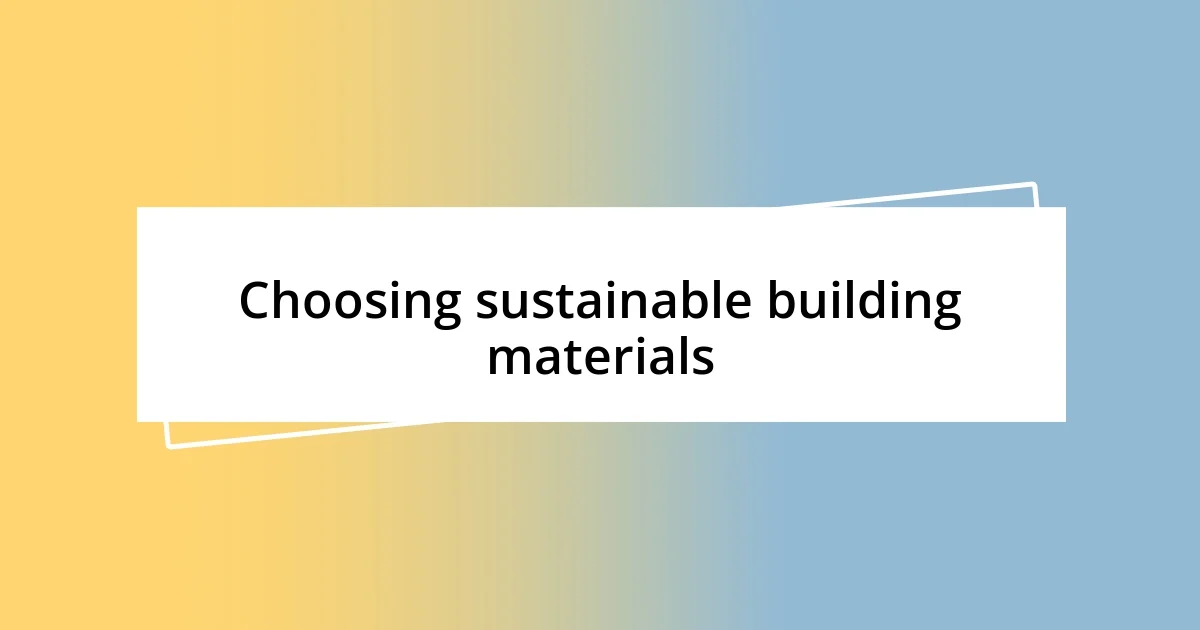
Choosing sustainable building materials
Choosing sustainable building materials can be a game-changer in the quest for a zero-energy home. When I was selecting materials, I focused on those that were not only durable but also had a low environmental impact. For instance, using reclaimed wood not only adds character but also reduces the demand for new lumber, which in turn protects our forests. I still remember walking through a salvage yard, overwhelmed by the beauty of the old beams and boards; it felt like I was giving new life to something that could have been forgotten.
Another critical consideration was the insulation material. Initially, I didn’t realize just how crucial this choice would be. Fiberglass was standard in many homes, but I opted for cellulose made from recycled paper instead. Not only did it create a better thermal barrier, but the thought of using something that would have otherwise ended up in a landfill brought me immense satisfaction. There’s something truly rewarding about knowing the materials you use contribute positively to the environment.
Lastly, I learned that every choice counts, even when it comes to finishes and fixtures. I selected low-VOC (volatile organic compound) paints and finishes to ensure that indoor air quality remained high. The first time I painted a room with these materials, the difference in smell was noticeable, making the whole space feel healthier and more welcoming. It really warmed my heart to know that my decisions not only benefited my family but also contributed to a more sustainable future.
| Material | Benefits |
|---|---|
| Reclaimed Wood | Reduces demand for new lumber, adds character |
| Cellulose Insulation | Better thermal performance, eco-friendly |
| Low-VOC Paints | Improves air quality, healthier living environment |

Designing an efficient layout
Designing the layout of a zero-energy home plays a significant role in optimizing energy efficiency. I remember standing in my empty space, envisioning how each room could interact with natural light and airflow. It felt like a puzzle, where every piece had to fit perfectly to create an energy-efficient haven. A well-thought-out layout can dramatically reduce reliance on heating and cooling systems, making the space feel comfortable year-round.
Here are some essential considerations that guided me during the layout design:
- Orientation: Position your home to maximize sunlight exposure, particularly with south-facing windows.
- Open Spaces: Create open areas that encourage airflow, reducing the need for artificial climate control.
- Zoning: Designate areas for heating and cooling based on usage patterns, concentrating energy where it’s most needed.
- Window Placement: Strategically place windows for natural light while preventing unwanted heat loss.
- Thermal Mass: Incorporate materials that absorb heat during the day and release it at night to stabilize indoor temperatures.
I truly found joy in creating spaces that would be both functional and ecologically friendly. Each decision—like placing a large window where I could catch the morning sun—added to the sense of tranquility I sought in my home. It was a fulfilling experience, knowing that my choices were paving the way for a sustainably comfortable living environment.
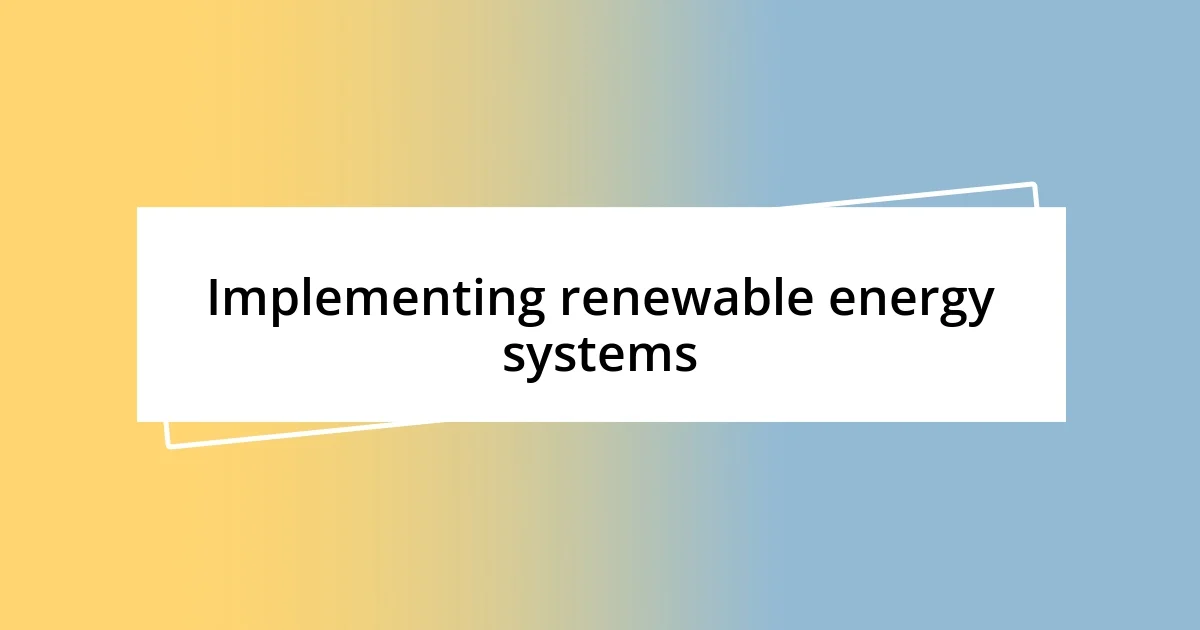
Implementing renewable energy systems
Implementing renewable energy systems was a turning point in my zero-energy home journey. I decided on solar panels after realizing how reliant I had been on the grid. The first time I saw the inverter light up, I felt a rush of pride—this was energy I had harnessed from the sun, a gift that kept giving. It was fascinating to watch my meter spin backward and understand that I was producing more energy than I consumed.
I also explored the benefits of a geothermal heating and cooling system. I remember feeling a sense of exhilaration when I learned how this system uses the earth’s consistent underground temperature to regulate indoor climates. As I dug deeper into the installation process, I couldn’t help but marvel at the engineering behind it. It felt like I was tapping into the planet’s natural resources in a way that was harmonious and sustainable. Have you ever considered how much energy you could save by using nature’s gifts?
To complement these systems, I invested in a home battery storage solution. The idea of storing solar energy for use during the evening was exhilarating. I vividly recall the first dark evening when my lights flickered on without a hitch, all thanks to the energy I had collected during the day. It was a liberating feeling to know that I was not just dependent on external power sources. This step truly brought me peace of mind, knowing I had the power to actively participate in energy conservation.
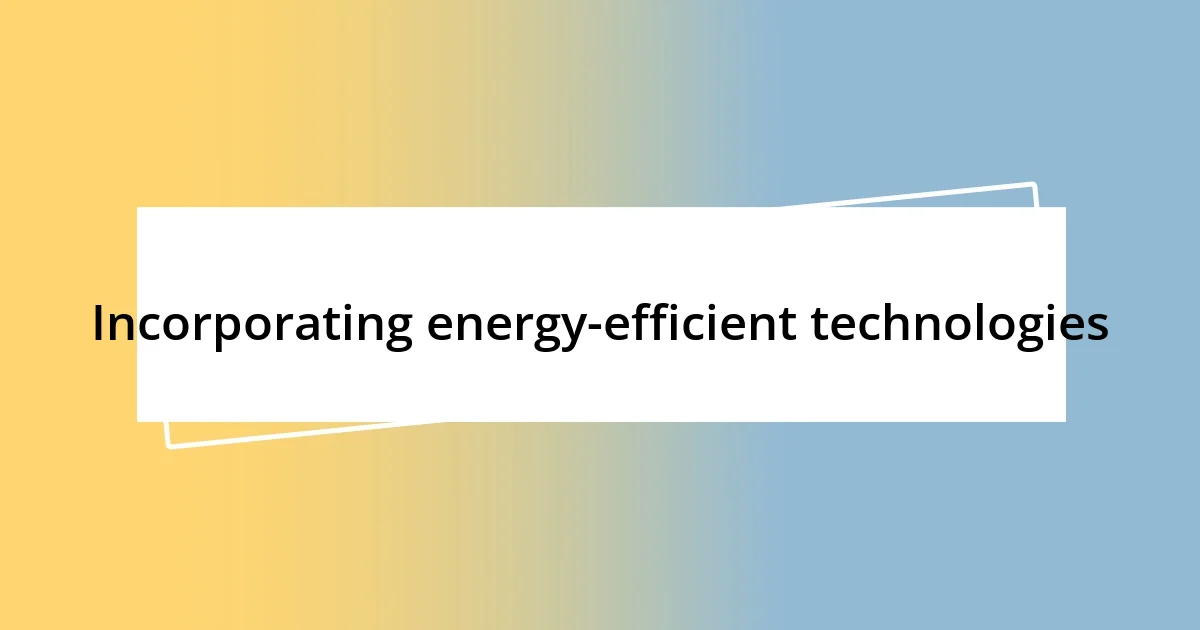
Incorporating energy-efficient technologies
Incorporating energy-efficient technologies transformed not just my home, but also my mindset about sustainability. I vividly remember when I first learned about energy-efficient appliances; switching to those smarter, eco-friendly options felt like a little victory. Each appliance came with the promise of cutting my energy use, and I could actually feel the difference in my energy bills. Have you ever noticed how a simple change in your choices can lead to significant savings?
I also took to heart the importance of smart home systems. Integrating smart thermostats and lighting that could adapt to my daily habits was a game-changer. The first time I used my smartphone to adjust the temperature before arriving home, I felt a sense of empowerment. It was as if I had a friendly assistant, always looking out for my comfort while minimizing energy waste. Seeing my home respond to my lifestyle while staying efficient was incredibly satisfying.
Lastly, I didn’t overlook the power of insulation and high-performance windows. When I upgraded to triple-glazed windows, it was like suddenly adding a protective layer against the elements. I remember the chill of winter when I realized I could enjoy a warm living room without cranking up the heater. That tangible comfort made the investment worthwhile, proving that energy-efficient technology creates a cozy, resilient space to thrive. What adjustments have you made to boost your home’s energy efficiency?
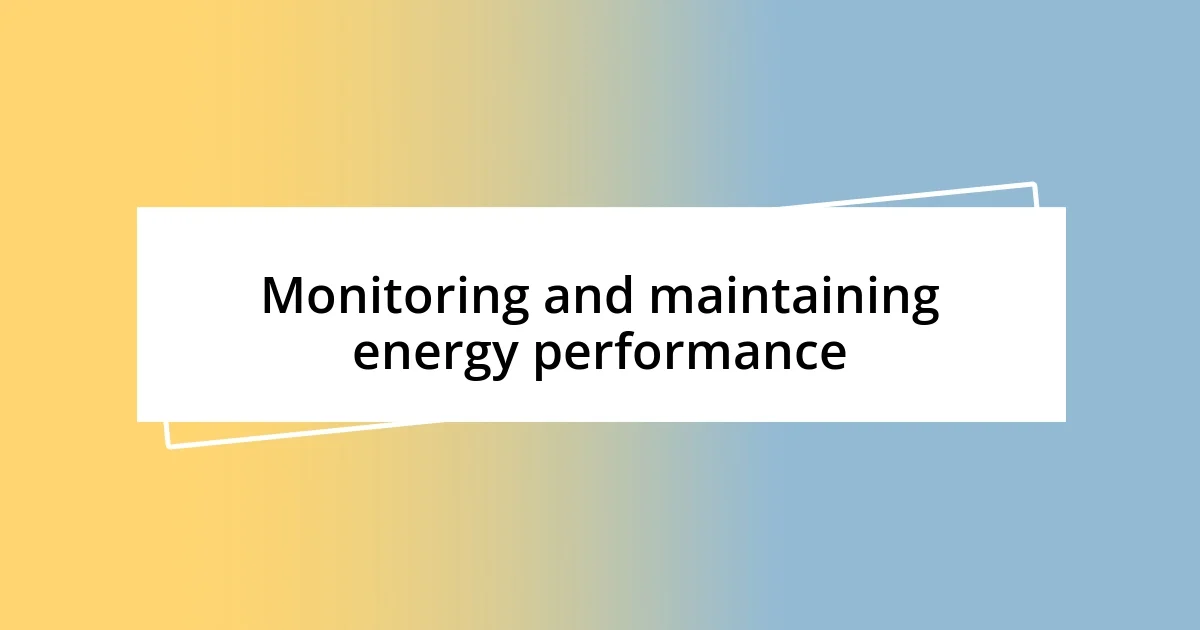
Monitoring and maintaining energy performance
Monitoring energy performance in my zero-energy home has been an enlightening experience. Every month, I take time to review my energy usage data, comparing it against my solar production. I remember the first month when I saw the numbers align perfectly, and it felt like a symphony where every element worked together seamlessly. Have you ever experienced that satisfying moment when everything just clicks?
I’ve also equipped my home with smart monitoring devices that provide real-time feedback. The first time my system alerted me about an unexpected spike in energy use, I was surprised, but it prompted me to investigate immediately. It turned out that a rogue appliance was consuming more than it should. This proactive monitoring allowed me to fix the issue quickly—something I never would have caught without those smart sensors. Don’t you think it’s crucial to catch those inefficiencies as they happen?
Furthermore, I’ve made it a habit to perform seasonal checks on my systems. I fondly recall a brisk fall afternoon when I meticulously cleaned my solar panels and inspected my geothermal system. I felt a sense of responsibility, knowing that these small actions directly contributed to my home’s energy performance. Maintaining these systems not only keeps my energy costs down but also fosters a deeper connection to my home. How do you stay engaged with your home’s energy performance?












